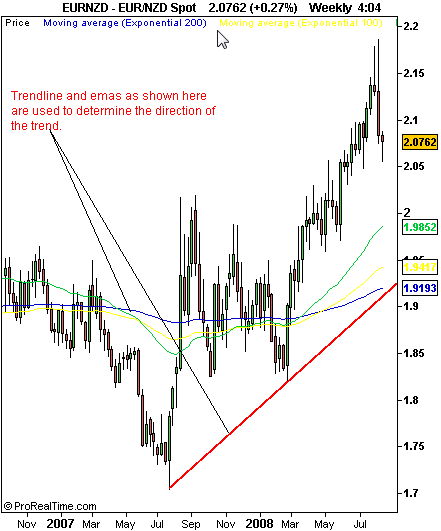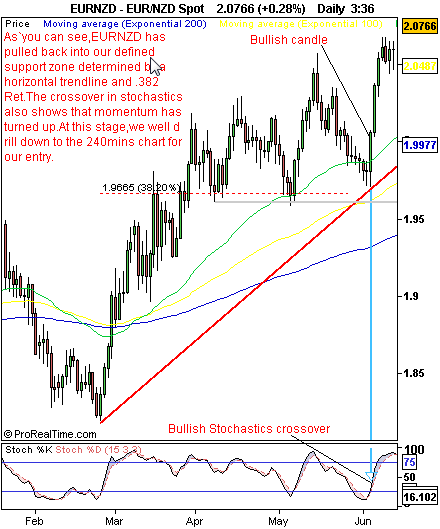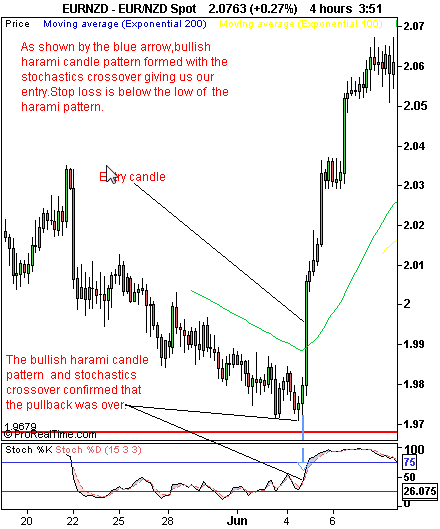Trading forex can be both interesting and rewarding if one can spend the time learning how it really works. First you have to build a base or foundation. That includes developing a strategy that works for you, finding good money management techniques and training your mind to be disciplined in all facets of trading. Remember, at the end of the day you must muster up enough courage to pull the trigger for any strategies developed to work.
What you will learn in this article is a pullback trading strategy that utilizes stochastics, simple support and resistance as well as Fibonacci retracement ratios to time trades in the direction of the primary trend. In my opinion, simple strategies work best in trading. And as simple as this strategy appears, keep in mind that no system is a bad system as long as it works and produces results for the owner. My honest advice is that you should stick to what works for you. If your strategy produces more winners (profits) than losers (losses) stick with it but re-evaluate it from time to time because market conditions might change so re-evaluations allow you to incorporate new changes in the market you trade into your strategy.
Terminology Used In This ArticleBefore we go into the discussion of this strategy, it is important for us to understand the key technical analysis tools we will utilize in this strategy. Don't worry if you don't fully grasp the definitions below. They will become clearer when I walk you through my strategy.
Stochastics: It is based on the rule that, within a period of strong market action, a market will tend to close towards the upper end of the range, while in downtrends, the price will close near the bottom of the range. Stochastics is made up of two lines; %K and %D that oscillate between 0 and 100. Overbought and oversold conditions are functions of this indicator, which could range between 80 on the upside and 20 on the downside. In addition, stochastics sometimes generates a divergence condition, which occurs when the indicator fails to confirm a move to a new price high or low in the price action.
Support and Resistance: Resistance is a price level above the market where supply is strong enough to overcome demand while support is a price level below the market where demand is strong enough to overcome supply. Price highs and lows as well trading ranges can exemplify support and resistance. Rectangle pattern tops and bottoms can serve as good examples of support and resistance levels.
Fibonacci Ratios: Are a sequence of numbers in which each successive number is the sum of the two previous numbers: 1, 1, 2, 3, 5, 8, 13, 21, 34, 55, 89, 144, 610, etc. Leonardo Fibonacci, an Italian born mathematician around 1170 discovered the relationship of what is now referred to as Fibonacci ratios while he was studying the Pyramid in Egypt. These numbers possess interrelationships, such as any given number is approximately 1.618 times the preceding number and any given number is approximately 0.618 times the following number. Fibonacci levels are relevant to traders because markets often bounce off key Fibonacci price levels. These levels can also act as support and resistance and can be used as projected profit targets.
Candlesticks: Are a way of displaying the relationship between opening and closing prices during a time interval.
If the close is higher than the open - the candle is white.
If the open is higher than the close - the candle is black.
Now that the meanings of our technical tools are understood, we will now move on to the fundamentals of this strategy. The parameters are set below:
1. The strategy takes a top-down approach to analyze allowing it to start from the higher time frames(weekly charts) and drill down to lower time frames(240mins charts)
2. We look for overbought and oversold readings on the stochastics indicator after a pullback in an uptrend and a rally in a downtrend.
3. We then watch price actions at our defined support and resistance levels to see if it would hold or violate these levels.
4. After establishing support & resistance, we will now plot our Fibonacci ratios to determine which Fib levels coincide with support and resistance zones, keeping an eye on the stochastic extreme readings.
5. Our focus is on signals that are going in the direction of the primary trend. We do not take trades or open positions against the primary trends, whether downtrends or up trends.
6. Lastly, we use reversal candle patterns as our entry triggers. These reversal candle patterns include hammers, bullish engulfing patterns and dojis etc.
7. Putting it all together: A close above the high of the previous days low when the stochastic indicator crosses over from the oversold zone and is above 20 (reading) coinciding with our established support & resistance/Fibonacci retracement and a reversal candlestick pattern gives us an entry.
Step OneEstablishing A Trend: Establish an uptrend (downtrend) on the weekly time frame. In this case, EMAs (50,100 & 200) and trendlines are used to determine the direction of the main trend. Below is a weekly chart of EURNZD cross, which has been in an uptrend since July 2007.
 Step Two
Step TwoMonitoring Pullbacks: After determining the direction of the trend on the weekly time frame, we will drill down to the daily chart in order to establish the trend (in the direction of the weekly trend) and also monitor pullbacks to know if it meets our strategy as defined above.
As you can see below, a pullback is already in place and price has moved into our defined support zone, but we still need to drill down further to 240-minute chart to see what price action and the stochastic indicator are doing. If price is hesitating or consolidating while stochastic is oversold, we then look for a reversal candle and a bullish stochastic crossover above oversold zone (reading above 20).
 Step Three
Step ThreeOn the 240-minute chart, price actually stalled ahead of our defined support/fib levels from the daily chart and a few ours later closed above the previous bearish candle to form a bullish candle pattern(bullish harami pattern). Furthermore, our stochastic indicator has already turned bullish above the oversold zone on the formation of the bullish engulfing pattern giving us an entry on the formation of the next candle. Stop losses are set 10 pips below the reversal candle.
 Conclusion
ConclusionThis strategy works on both downtrends and uptrends provided its defined parameters are followed. I use it as a swing trading strategy but for those interested in using it for day trading a little adjustment might be needed. Furthermore, refining your entries for low risk trades may take you below the 240mins chart, it is still all right as long as you are trading in the direction of the main trend. Depending on how you want to utilize the strategy, either as day trading or swing trading you can set your exit points based on your preferences but for me, I like using trailing stops. As stated in the beginning, simplify, simplify, simplify are the words I read every day as I begin my trading day. I love simple strategies because they work.